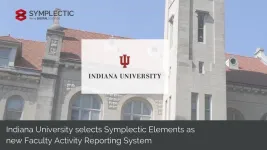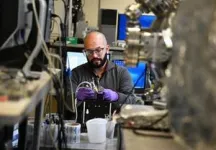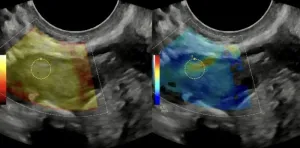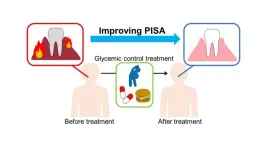(Press-News.org) Digital Science, a technology company serving stakeholders across the research ecosystem, is pleased to announce that Indiana University has selected Symplectic Elements as its new faculty activity management and reporting system.
This strategic decision marks a significant advancement toward the university’s goals of streamlining the management and reporting of the work and accomplishments of its faculty.
Indiana University is internationally known for outstanding research and its world-class degree programs, from business and health to STEM and the arts at its flagship campus in Bloomington, the expanding campus in Indianapolis and across the state through its seven regional campuses. It also operates the largest medical school in the United States.
Given the expansive variation of scholarship and teaching, a faculty-driven initiative determined the need for a new system to better address the needs of the diverse schools and colleges within the university organization. Symplectic Elements was selected as it is designed to meet the diverse needs of academic institutions.
“From selection to implementation, the transition to this tool has been a model of shared governance at work at Indiana University,” said Willie Miller, Assistant Vice Chancellor for Academic Affairs at IU Indianapolis, who serves on the implementation committee.
He went on to state, “Symplectic Elements has features that align with faculty values and the university’s priorities. It has the potential to improve the usability and equity in our systems of faculty review, connect IU faculty closer to each other for collaboration, and increase the visibility of faculty work externally, thereby strengthening the university’s reputation as a powerhouse of research and discovery.”
Symplectic Elements’ intuitive interface and powerful data integration capabilities will facilitate a smooth transition ensuring historical data is accurately migrated and preserved. The university will also utilize Symplectic Elements to underpin a new public profiles portal, opening discoverability across researchers and research outputs throughout all campuses.
About Indiana University
Indiana University is one of the largest universities in the nation. Founded in 1820, Indiana University is a public, multi-campus, state-supported educational institution with undergraduate and graduate full-time equivalent students from throughout the U.S. and the world exceeding 90,000. It has more than 21,000 faculty, professional and support staff that support its educational, research and public service missions.
About Symplectic
Symplectic works in pursuit of the advancement of knowledge, delivering flexible information management solutions that help universities, institutions and funders achieve their research goals.
Symplectic Elements is a highly configurable platform which ingests data from multiple sources to build a truly comprehensive picture of scholarly data and activities. With over 20 years of experience and 115+ clients, Symplectic Elements is trusted by universities, institutions and research organizations around the world.
About Digital Science
Digital Science is an AI-focused technology company providing innovative solutions to complex challenges faced by researchers, universities, funders, industry and publishers. We work in partnership to advance global research for the benefit of society. Through our brands – Altmetric, Dimensions, Figshare, IFI CLAIMS Patent Services, metaphacts, OntoChem, Overleaf, ReadCube, Scismic, Symplectic, and Writefull – we believe when we solve problems together, we drive progress for all. Visit www.digital-science.com and follow @digitalsci on X or on LinkedIn.
Media contacts
Simon Linacre, Head of Content, Brand & Press, Digital Science: Mobile +44 7484 381477, s.linacre@digital-science.com
David Ellis, Press, PR & Social Manager, Digital Science: Mobile +61 447 783 023, d.ellis@digital-science.com
END
Indiana University selects Symplectic Elements as faculty activity reporting system
2024-09-17
ELSE PRESS RELEASES FROM THIS DATE:
Stephenson Prize for Innovation in Pancreatic Cancer Research launched with $150 million gift to City of Hope
2024-09-17
LOS ANGELES — City of Hope®, one of the largest and most advanced cancer research and treatment organizations in the U.S. and ranked among the nation’s top 5 cancer centers by U.S. News & World Report, has received a historic $150 million gift from entrepreneurs and philanthropists A. Emmet Stephenson Jr. and his daughter Tessa Stephenson Brand to immediately fund pancreatic cancer research.
The centerpiece of this gift is the $1 million Stephenson Prize, one of the largest ...
New understanding of the limits on nano-noise
2024-09-17
Thanks to nanoscale devices as small as human cells, researchers can create groundbreaking material properties, leading to smaller, faster, and more energy-efficient electronics. However, to fully unlock the potential of nanotechnology, addressing noise is crucial. A research team at Chalmers University of Technology, in Sweden, has taken a significant step toward unraveling fundamental constraints on noise, paving the way for future nanoelectronics.
Nanotechnology is rapidly advancing, capturing ...
Graphite oxidation experiments reveal new type of oscillating chemical reaction
2024-09-17
A reaction that puzzled scientists for 50 years has now been explained by researchers at Umeå University. Rapid structural snapshots captured how graphite transforms into graphite oxide during electrochemical oxidation, revealing intermediate structures that appear and disappear over time. The researchers describe this as a new type of oscillating reaction.
Oscillating chemical reactions are fascinating to watch and important for developing an understanding of how complex systems work, both in chemistry and in nature. Classical visual examples of such reactions show how the colors of a solution change back and forth, cycling ...
How does a tiny shrimp find its way home in a vast ocean? Study finds it’s down to their cave’s special smell
2024-09-17
Homing is an animal’s ability to navigate towards an original location, such as a breeding spot or foraging territory. Salmon and racing pigeons are famous for homing, but similar behaviors occur in groups as diverse as bees, frogs, rats, and sea turtles. There, homing individuals are known or suspected to rely on landmarks, the Earth’s magnetic field, or the sky’s pattern of polarized light to find their way back.
Another group known to display homing are cave-dwelling mysid shrimp, also known as possum shrimp for the pouches in which females carry ...
‘Marine identity’ can help restore the ocean
2024-09-17
People’s deep connection with the ocean – their “marine identity” – can help us reset society’s relationship with the seas, new research led by Dr Pamela Buchan, from the University of Exeter, suggests.
A diverse, international group of marine researchers and practitioners met to discuss marine identity – based on testimony and photos from multiple countries.
The group included Diz Glithero of the Canadian Ocean Literacy Coalition, Dr Emma McKinley of Cardiff University who helped deliver the workshop, and others from across Europe, Africa, Indonesia, North America, and Australasia.
They found many common themes, including traditions ...
Evidence shows that estrogen blocker treatment does not increase the risk of coronary heart disease in breast cancer patients
2024-09-17
New evidence shows that extended estrogen suppression treatment using an aromatase inhibitors for hormone receptor-positive postmenopausal breast cancer is safe; it does not increase the risk of coronary artery calcification, a sign of active coronary atherosclerosis, as some prior studies had indicated. An article in the Canadian Journal of Cardiology, published by Elsevier, details the findings from a retrospective, cross-sectional observational study that investigated the association between the duration of aromatase inhibitor treatment and the severity of coronary artery calcification in postoperative breast cancer patients.
Coronary ...
Survey shows 25% of adults consider weight loss drug use without prescription
2024-09-17
COLUMBUS, Ohio – Injectable weight loss drugs are popular right now but can be hard to get because they are in short supply or too expensive without insurance. The result is that some people are skipping the doctor’s office and reaching out to potentially unreliable sources such as unlicensed online pharmacies or telehealth sites, which could expose patients to risks.
A new national survey from The Ohio State University Wexner Medical Center reveals 1 in 4 (25%) of 1,006 adults surveyed would consider using an injectable weight loss medication without consulting their doctor. The reasons ...
New treatment extends ovarian function in older mice
2024-09-17
Medication to reduce ovarian scarring helps extends overall health of reproductive system
Freezing eggs only addresses age-related infertility, not ovarian hormone loss. New treatment would ‘fix the root of the issue’
Findings also have implications for developing treatments for ovarian cancer
CHICAGO --- A woman’s ovaries are like a factory where eggs grow and produce hormones that regulate everything from menstruation and pregnancy to bone density and mood. As she and her factory age, production dwindles, and by the time she hits menopause ...
Getting to the root of the problem: Intensive diabetes treatment reduces gum disease inflammation
2024-09-17
Osaka, Japan – While the link between diabetes and periodontal disease is known, the impact of diabetes treatment on periodontal health is less well understood. Recent research published in Diabetes, Obesity and Metabolism demonstrates that periodontal inflammation can be positively affected just by receiving intensive diabetes treatment.
It is widely believed that there is an interrelationship between diabetes and periodontal disease. While it has been shown that treatment of periodontal disease improves blood ...
Researchers take power and efficiency of biological sensing to record level
2024-09-17
University of Arizona researchers have developed a new biological sensing method that can detect substances at the zeptomolar level – an astonishingly miniscule amount.
This level of sensing, immediately useful for drug testing and other research, has the potential to make new drug discoveries possible. Eventually, the advance could lead to portable sensors that can detect environmental toxins or chemical weapons, monitor food quality or screen for cancer.
A paper describing the results was published in the journal Nature Communications on Aug. 28.
Judith Su, associate professor of biomedical engineering and optical ...









